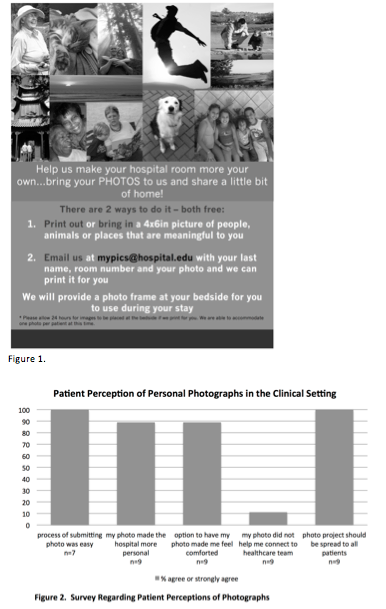Background: Given that the hospital can be a depersonalizing and stressful environment for patients and families, healthcare teams should help ensure hospitalized patients feel respected as individuals. While studies suggest that displaying personal photographs at the bedside can increase the delivery of empathic care, the impact of photographs on patient experience in the hospital is relatively unexplored.
Purpose: To determine whether providing hospitalized patients with the opportunity to place a photograph of something meaningful to them at their bedside individualizes their hospital experience and fosters a connection with their healthcare providers.
Description: During the months of October and November 2015 we piloted the delivery of flyers to a convenience sample of alert patients or patients with a caregiver at the bedside. An estimated 40 flyers were delivered by hospitalists and volunteers. The flyers (Figure 1) described the purpose of the project and the ways to get a printed photograph to patients. Patients or their families could either 1) bring in a photograph from home or 2) email their photograph as a file to a HIPAA compliant email account associated with their hospital unit. Simple clear plastic frames were purchased at a cost of $1.25 each. We employed the photo printer previously used only for wound care rounds. The email account was checked daily and photographs were delivered directly to patient rooms by hospitalists and volunteers. When the photographs had been at the patient bedside for greater than one day, patients and families were surveyed to assess their reaction to the photograph and whether it had any effect on their hospital stay and/or their interaction with their healthcare team.
In total, 13 photographs were delivered and the survey was administered to 9 patients and families. Four patients were unable to complete the survey due to early discharge and/or precluding medical comorbidities. Responses are shown in Figure 2.
Conclusions: Enabling patients to place a personal photograph at their bedside proved to be a simple, low-cost, comforting way to personalize the clinical setting and may help foster connections between patients and their healthcare team. Future steps include exploring how this intervention impacts patient-reported outcomes such as satisfaction with the overall hospital experience, and assessing what effects the photographs have on healthcare providers and care delivery.
